Walter Crane et la littérature de jeunesse (2)
MISAJOUR 20120729
17 janvier 2012 13:39 0 messages
![]() Cet article fait suite à la première partie des notes de lecture de l’autobiographie de Crane
Cet article fait suite à la première partie des notes de lecture de l’autobiographie de Crane
![]() 3ème partie
3ème partie
![]() 4ème partie
4ème partie
1863, c’est donc l’année d’Edmund Evans, et c’est le début d’une collaboration artistique de toute une vie :
During the year 1863 I had an introduction to Mr. Edmund Evans, and thus commenced a connection which has lasted to the present time, though Mr. Wilfred Evans now manages his late father’s business.
Mr. Evans was one of the pioneers in the development of colour-printing, and not only did a quantity of ordinary trade work in this way, but also choice books.
One of the directions in which his craft was extensively used was that of covers of cheap railway novels, which we sometimes called from their generally yellow hue and sensational character, « mustard plaisters. »
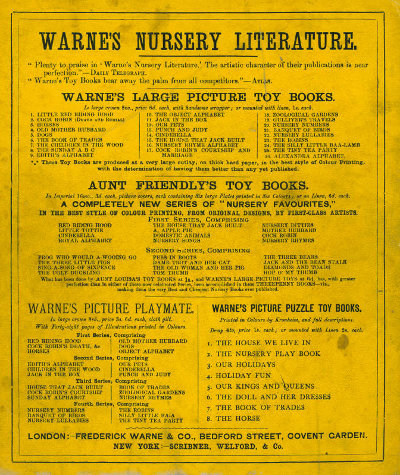
Designs of this kind were my principal work for Mr. Evans at first, but later (about 1865) I began to design for him the children’s picture-books published by the house of Routledge and Sons which afterwards attained such popularity.
The first, however, were done for Messrs. Warne. They were a History of Cock Robin and Jenny Wren, Dame Trot and her Comical Cat, and The House that Jack built. They were designed with solid black or blue backgrounds, the figures being relieved against them in bright colours.
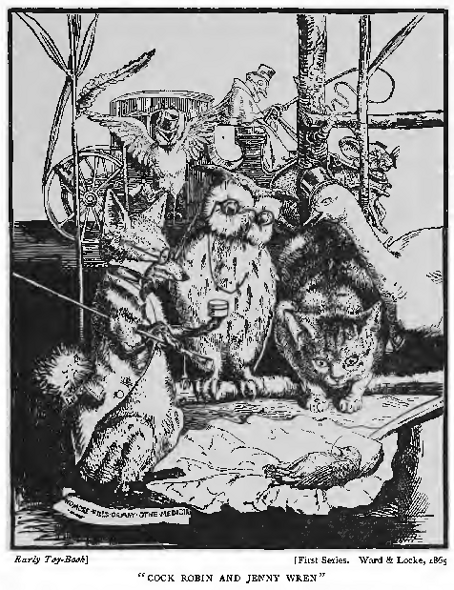
qui sera repris quelques années plus tard dans un livret de chansons traditionnelles avec partition, et dont voici les paroles
’Twas on a merry time,
When Jenny Wren was young,
So neatly as she danced,
And so sweetly as she sung,
Robin Redbreast lost his heart,
He was a gallant bird,
He doffed his cap to Jenny Wren,
Requesting to be heard.
"My dearest Jenny Wren,
If you will but be mine,
You shall dine on cherry pie,
And drink nice currant wine ;
I’ll dress you like a gold-finch,
Or like a peacock gay,
So if you’ll have me, Jenny, dear,
Let us appoint the day."
Jenny blushed behind her fan
And thus declared her mind—
"So let it be to-morrow, Rob,
I’ll take your offer kind ;
Cherry pie is very good,
And so is currant wine,
But I will wear my plain brown gown,
And never dress too fine."
Robin Redbreast got up early,
All at the break of day,
He flew to Jenny Wren’s house,
And sang a roundelay ;
He sang of Robin Redbreast,
And pretty Jenny Wren,
And when he came unto the end,
He then began again.
The series for Messrs. Routledge commenced with a Farmyard Alphabet and a Railway Alphabet, printed in two colours only, in addition to the key block.
These were followed by designs of figures without backgrounds printed in red, blue and black, of which The Song of Sixpence is a type ;
But gradually more colours were used as the designs became more elaborate, until a few years later they had developed, under various influences, among which that of Japanese colour prints must be counted as an important factor : The Fairy Ship and This Little Pig are examples of this period.
- The Fairy Ship : musique de "The Sailor Song", dans l’album "FanTastic" de 1999, du groupe de pop danois "Toy-Box" formé par Anila Mirza et Amir El-Falaki.
Ces textes ont été réédités par la suite, après "remaniement".
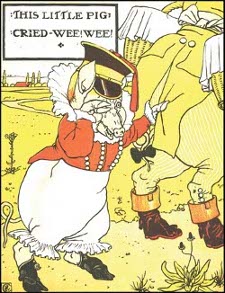 |
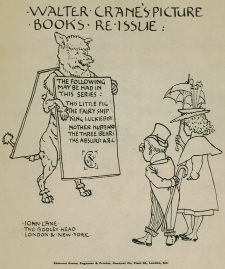 |
La chronologie précise de publication des "toy books" se trouve
- dans la bibliographie de l’Elizabeth Newbitt Room
- et dans le catalogue des lecteurs du British Museum.

Images et didactique
Walter Crane ne se contente pas d’illustrer des comptines, il se lance aussi dans l’aide aux apprentissages de base, à la manière d’un maître préparant des images colorées susceptibles de servir de support au langage oral pour des pré-lecteurs.
Comme l’écrit L. Delaney, il "met en lien les mots grammaticaux avec les jeux et les jouets dessinés pour qu’un enfant se sente concerné." Par exemple, ici, la sortie des couples d’animaux de l’arche de Noë traçant un zigzag jusqu’à la petite fille assise, permet d’y accrocher des adjectifs de couleur ou de taille.
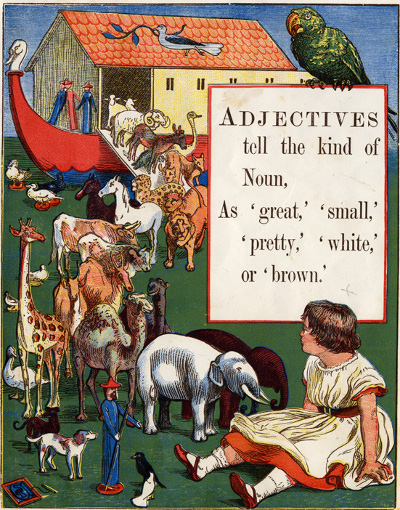
L’humour est toujours présent, avec le volatile perché sur le panneau, qui est là pour rappeler qu’une leçon de grammaire s’apprend comme un perroquet ;

et la signature également, qui se cache parfois dans un élément du décor, comme ici sur le poteau derrière les deux pêcheurs.
Parallèlement à l’illustration des "toybooks" sa plume est sollicitée pour des couvertures d’ouvrages, comme la réédition de "Farina" de Meredith.

1863, c’est aussi un choix philosophique,
celui de la libre pensée
Aided by such books as Phases of Faith by F.W. Newman, and rather a wide range of reading from the time onward, including the writings of J.S. Mill, Darwin and Herbert Spencer, and above all the poems of Shelley, I soon decided for Free Thought.
We had formed a book club or reading fund in the family for the acquisition of books, and we also had a subscription at Mudie’s, so that the supply was kept up. Some of us also attempted writing short essays on various subjects, which were read in the family circle and discussed.
Reading, too, of Auguste Comte and the Positivists may have had some effect, and I remember attending one ot the London Positivists Society’s meetings at a large room, I think in Bouverie Street, where Professor Newton, who was one of the leaders, delivered an address...
The stir of great movements was in the air. The discoveries and conclusions of Charles Darwin were startling the world, and scientific criticisms were revolutionising philosophic thought.
Comme l’écrit Lesley Delaney, c’est depuis la petite enfance qu’il jouit de ce bonheur de partager en famille les joies de la lecture, "his family’s shared enjoyment of books."
Il suit des cours d’art le soir, et fait partie du "sketch club" qui regroupe les étudiants :
We had exhibition nights, where the sketches which had been made in response to a given subject, would be celebrated by evening entertainments, in which generally some theatricals formed the "pièce de résistance".
et se passionne pour la découverte de certains peintres contemporains engagés, comme Madox Brown :
It was during this year, in 1865, that Mr. Madox Brown opened the very remarkable and interesting exhibition of his works at a small gallery in Piccadilly. It was a collection of both early and late work, and his latest most important picture, entitled "Work" was here seen for the first time.
I shall never forget the impression that the work of this most remarkable artist made upon me. The absolute sincerity, the conviction with which every subject was handled and painted, the extraordinary penetrating power of each picture, charged as it was with subtle thought and significant detail, gave an unusual distinction and peculiar and marked individual character, by which the work of F. M. Brown (with all its whimsicalities and quaintness, which are essential elements in it) stands out in the history of English art.
C’est ici un des aspects importants de l’activité de Walter Crane, comme "critique d’art", qui fait penser à la plume de Baudelaire dans ses "Curiosités esthétiques" parues en 1868.
Anything like a philosophical conception of art seems so rare, one seldom in art criticism perceives anything like a conception of its growth and evolution, and the necessity of change, and transformation even both in form and method as the accompaniment of life and movement, and in correspondence with the changing mental attitude in each succeeding generation.
No doubt commercial exigencies have much to do with it, consciously or unconciously, but it appears in some quarters as if there was one kind or phase of painting to be admired — at least, among the living.
Modern painting, however, always offers a chance for individual distinction, and with the increase of exhibitions, and the development of specialism, originality, or individuality, may now have a better chance of recognition than formerly — but I do not know that it is more plentiful, while imitators increase.
Mais ce n’est pas l’objectif premier de ses "reminiscences" : ici Walter Crane parle surtout de ses rencontres et des amis et collègues qui l’ont peu à peu aidé à construire sa propre personnalité.
The curtain had been lifted, and we had had a glimpse into a magic world of romance and pictured poetry, peopled with ghosts of "ladies dead and lovely knights" — a twilight world of dark mysterious woodlands, haunted streams, meads of deep green starred with burning flowers, veiled in a dim and mystic light, and stained with low-tones crimson and gold, as if indeed one had gazed through the glass of
Magic casements opening on the foam
Of perilous seas in faerylands forlorn.
(from Keats, Ode to a nightingale)
Il forme avec quatre camarades peintres de paysage, ce qu’il appelle une "clique" :
Wooldridge used to join me in Derbyshire, where, in the later time with my brothers and sisters, we were often a merry party at Hazelford. We used to be fond of caricaturing the incidents of the day, and also each other. Wooldridge was always musical, and was acquainted with the fine composers of the 17th and 18th centuries long before their recent re-discovery. He was also a singer of taste. This accounts for the emblems with which I have surrounded him in the little fancy sketch. In the other I am a sort of Colin Clout. The third sketch is an anticipation of our friendship in old age — discussing a bottle of old crusted port. These are only a few out of many — I mean sketches, not bottles of port.
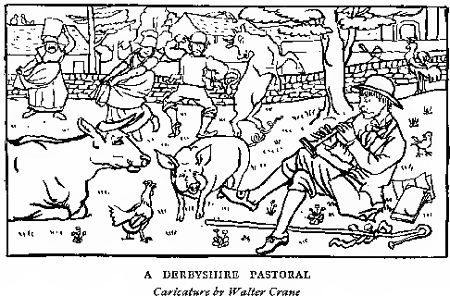
 |
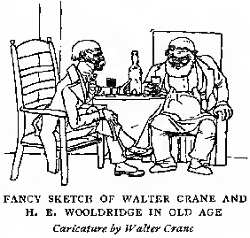 |
Another comrade was A. Sacheverell Coke. He had much facility of design, and sought his subjects in classical mythology. He afterwards designed the tile-work for the interior of the St James’s Restaurant grill-room, the subjects being the gods and goddesses of Greek and Roman mythology, with incidents in their history.
Whether their influence improved the flavour of the chops and steaks I do not know, bit it might be truly said the gods certainly were never without burnt sacrifices on the grill.
Mais ce groupe de jeunes peintres n’arrive pas à "percer".
The group of young painters I have mentioned, of whom my friend Robert Bateman was a leading member, continued to show their work at the Dudley Galery, and where rather chaffed by the critics, if not occasionally abused. One of them by a creative effort even invented a phrase, and characterised us as the "Poetry-without-Grammar Shool," whatever that might mean.
La description de "cadres de vie" des personnages qu’il rencontre est aussi détaillée que s’il en avait fait une photo, ainsi de la maison des parents de Bateman :
The house was rather a show house, and more especially its grounds, which comprised flower and formal gardens in the manner of many different countries, Italian, Dutch, etc., beautifully laid out and kept.
There was even a quaint little Chinese garden among them, with a bridge which might have come out of the willow-pattern plate, and real China roses.
I remember, toot, in the house a long gallery, on the walls of which were illustrated the geological sections of the earth’s crusts done in the actual materials, the carboniferous seams let in in real coal, and so on — a thing not seen before.
Il expose un tableau en 1868 représentant :
two armed and crested warriors on horseback, fighting upon the banks of a river, which wandered through a vast plain in shining curved, catching the light of dawn ; beyond were ranges of mountains, and, dimly seen, at each bend of the river, monuments of past ages appeared in ruin — a Celtic dolmen, an Egyptian gateway, a classican temple, a Gothic abbey ; and the foreground was littered with skeletons, crowns, and emblems of fallen or decaying powers.
Mais ce tableau c’est aussi un message concernant la véritable révolution provoquée par les découvertes et recherches de Darwin et Spencer :
This design marked the revolution which was taking place in my mind as regards religion and the conception of life and the course of history.
I entertained an ardent idea to embody the new philosophy of evolution.
One felt that a new epoch of thouht had dawned upon the world, and longed to give it some artistic expression.
Au printemps suivant, il soumet (sans succès) son premier poème lyrique, écrit dans le comté de Gloucester :
Here it was a joy to watch the advance of spring — the woods gradually changing from purple and red to green and gold, and shot with the blue of hyacinths that seemed to float almost like clouds between the beech stems.
Such sights as these meeting one’s eyes day by day filled one with the idea of a universal spring like a gracious presence moving everywhere.
February 1866, first glimpse at Paris
Paris then was under the Second Empire. The old Palace of Tuileries was intact and the Vendôme Column, and there was a general pervading air of reverence and glorification of the Napoleonic legend about the public places and monuments, and the big N surrounded with a laurel wreath was a very frequent emblem. The military were much in evidence, and there was a great display of various uniforms and of crinoline on the part of the ladies.
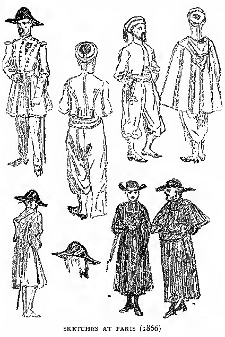 |
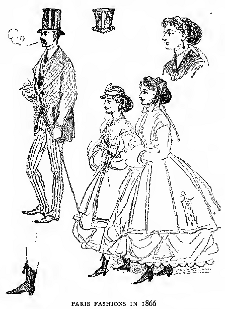 |
I recall, above all, the deep impression I had from the great masterpieces of the Louvre, and worshipped at the shrine of the Venus of Milo. These remain, but what of the Empire ?
Il en profite aussi pour croquer de nombreuses scènes :
En voici le titre A hint for the horticultural society. Great show of "chignons." Medal awarded to the finest grown specimen.
Et voici les inscriptions : Chignon unnaturelle pastrubfranes, chignon vulgaris, chignon dressairia, chignon curlironia, great show searson, chignon horsairia, honourable mention. Used in Punch July 21/66 / drawn by Walter Crane.
Les événements politiques commencent à l’atteindre et il s’intéresse de près aux bouleversements vécus à Londres, il écoute attentivement les discours des orateurs et nous décrit leur style, par exemple John Bright :
He had a fine resonant rich voice, and all the hidden art of a practised and eloquent speaker, so that it seemed as if he were playing upon the emotions and passions of a great audience, as a pusician plays upon some instrument, evoking some instrument, evoking instant response to his skill and feeling.
Political excitement did not, however, interfere with my ordinary work, and in some ways helped to inspire it, as about this time I mde a design for a pictorial composition on the theme of Freedom, in which Humanity was personified by a youth chained in a prison and guarded by the figures of a king in armour sitting on one side, and a cowled priest with a book and crozier on the other... the appearance of Freedom... wearing a "bonnet rouge".
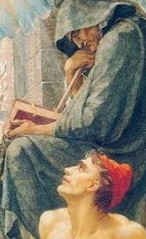
Un éclairage complémentaire sur la vie sociale de Walter Crane nous est fourni par une correspondance qu’il a échangée pendant plusieurs années avec Annie et Nellie Booth.


cf. l’étude suivante : Walter Crane and the rhetoric of art, a paper by David Gerard, 2002
et Lesley Delaney, Walter Crane promoting Visual Literacy in Nursery Picture Books, 31/03/2011.
Dans la même rubrique
7 janvier 2019 – Rose de l’an neuf
26 novembre 2018 – Gustave Doré in London in 1872
19 novembre 2018 – Marie-Madeleine Dauphin
20 janvier 2017 – Énigme policière dans la Ferme des Animaux
6 août 2016 – La Joie de vivre






